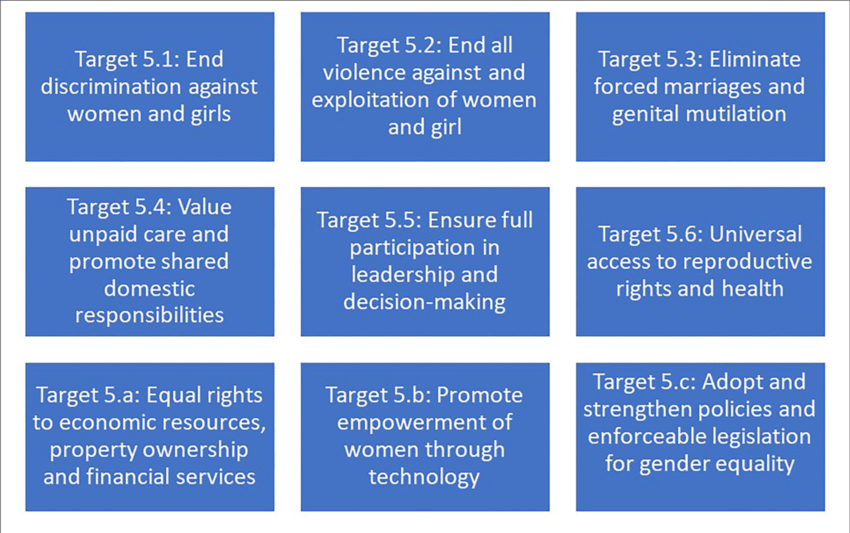SDG05 in the classroom: Achieve Gender Equality and Empower all Women and Girls
At the end of this lesson the student will be able to:
- Estimate the numbers of key factors on SDG5.
- Compare digital stories on SDG5.
- Propose solutions for SDG5 digital stories.
- Define the concept of women empowerment.
- Explain the importance of women empowerment.
Before diving into the topic, learn about data and misconceptions on gender equality.
Activity 1. Play SDG5_QUIZ this quiz together with your students regarding misconceptions on data about gender equality. The option with the majority of the votes will be selected. Whether right or wrong, read carefully the explanation that follows each answer to clarify each topic.
Possible adaptations: 1. (Online) You can send the link to your students and let them play individually. Afterwards, read the explanations that follow each question. 2. (Online) You can share your screen on your video platform and play with your students by collecting their votes in the chat section. Read the explanation each time after each question.
Gender equality is the 5th SDG established by the United Nations.

It regards and affects numerous spheres of women’s and girls’ lives.
If trends continue this way, it is unlikely by the year 2030 that many countries will achieve the gender equality targets. Moreover, the Covid-19 pandemic has caused the exacerbation of existing inequalities. Further information can be found in the SDG5 Report 2021.
Nevertheless, some progress has been achieved in the last decades. For instance, today more girls are enrolled in education than ever before.
Show the hidden numbers and let students guess the hidden numbers in the images (the original version can be found here). This activity can be done individually or in groups with the facilitation of the teacher.






Possible adaptations: 1. Other numbers can be selected according to your needs. You can show it all together or one by one to take time to reflect on each case. 2. A quiz version can be created through Google Form (quiz) or any other tool.
Discussion time linked to Activity 2 through the suggested questions.
- Which one is the most surprising fact to you in the image? Why?
- What would change if women and men would equally commit to domestic work?
- In what setting\context do you personally experience or witness gender equality?
- In what setting\context do you personally experience or witness gender inequality?
- Female genital mutilation is a harmful practice1. Do you know other existing ones?
- Is sexual harassment a form of violence? What else is considered a form of violence against women?
- What are the consequences of such violent actions on women2?
- What could you do to help a friend who is a victim of domestic violence?
1 Notes for teachers. More information about harmful practices can be found here (UNICEF), here (Cameroon) and here (Honor killings)_Amnesty International
2 Note for teachers: More on Women's health consequences (WHO).
Watch digital stories of empirical cases of gender equality issues. Then, complete the exercises below each table. The first two stories tell harsh facts on girls’ lives while the last two aim to hasten women empowerment.
[Target 5.3] Eliminate all harmful practices, such as child, early and forced marriage and female genital mutilation.
2. Sexual Harassment - Mozambique
[Target 5.2] Eliminate all forms of violence against all women and girls in the public and private spheres, including trafficking and sexual and other types of exploitation.
Select one of the two digital stories and propose a solution to prevent these actions to occur.
Possible adaptation: Separate the students equally into 2 groups and assign 1 story to each group to come up with at least 2 main solutions per case.
3. Empowering women - Philippines
4. Let’s be courageous for gender equality - Iran/Belgium
Based on what you have learnt in videos 3, 4, and 5, define the concept “women empowerment”.
- Why is “women empowerment” necessary for the achievement of SDG5?
- What action could you take in your daily life to empower women?
- How can we achieve more women empowerment?
Watch this video_Signal Help to learn how to use and recognize the universal signal for help (Domestic Violence). Afterwards, practice the gesture signal.
Possible adaptation: ROLEPLAY; In groups of 3 students, ask to take each a different role per turn (the victim, the friend and the partner). Make sure the partner doesn’t act violently in the scene but he is present (remind the student that the victim can ask for help by showing this signal when the circumstances allow). The play should be about 2 minutes maximum each. Ensure all the students take up all the different roles.
This quiz is about UN Goal 5: Achieve Gender Equality and Empower all Women and Girls. You can either use it at the end of your lesson to revise the topics you have already talked about, or in the beggining of the lesson to challenge students prior knowledge and gain their attention.
Pedagogical twist For SDG5 (gender equality) sheet, our favourite pedagogical twist is: Ensure support and confidentiality: in the beginning of the lesson explain that the topic in question is very broad and due to time limitation, it is impossible to focus on every aspect of it with the attention it deserves. Therefore, tell students that if there are topics they want to talk about, even related to personal experiences or problems, they can reach out to you by leaving a little message in a box in the class. They can be free to write their name on it or keep it anonymous. The box will be removed every day, safely stored and relocated for the next class (this should be done for a few weeks in a row to ensure everyone has got the chance to ask something). It is up to you how to proceed in the case someone confidentially confides in you (e.g. private meeting in school or outside). If you have another pedagogical twist in mind, feel free to apply or check the pedagogical twist list.
- Further data on SDG5: https://unstats.un.org/sdgs/report/2019/Goal-05/
- Informative website to raise awareness and action to help victims of violence What Bystanders can do
- Girl Rising | Ethiopia Chapter “Written by Maaza Mengiste and voiced by Meryl Streep, Azmera’s chapter is one of nine remarkable stories from the Girl Rising film. When 13-year old Azmera is told she must marry, she does something shocking; she says no”.

A gift for Comundos
Over the years, Comundos has helped remote communities around the world by teaching critical thinking, media literacy and the use of communication technology.
To do this effectively, we need your support for computers, translations, courses and social media management.
Thank you .
BE11 1030 2973 8248




